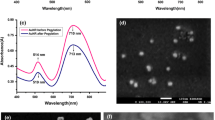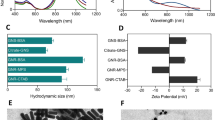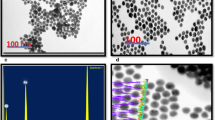Abstract
This paper explores the adhesion of biosynthesized gold nanoparticles (AuNPs) and gold (Au) nanoparticle/prodigiosin (PG) drug nanoparticles to breast cancer cells (MDA-MB-231 cells). The AuNPs were synthesized in a record time (less than 30 s) from Nauclea latifolia leaf extracts, while the PG was produced via bacterial synthesis with Serratia marcescens sp. The size distributions and shapes of the resulting AuNPs were characterized using transmission electron microscopy (TEM), while the resulting hydrodynamic diameters and polydispersity indices were studied using dynamic light scattering (DLS). Atomic Force Microscopy (AFM) was used to study the adhesion between the synthesized gold nanoparticles (AuNPs)/LHRH-conjugated AuNPs and triple negative breast cancer cells (MDA-MB-231 cells), as well as the adhesion between LHRH-conjugated AuNP/PG drug and MDA-MB-231 breast cancer cells. The adhesion forces between LHRH-conjugated AuNPs and breast cancer cells are shown to be five times greater than those between AuNPs and normal breast cells. The increase in adhesion is shown to be due to the over-expression of LHRH receptors on the surfaces of MDA-MB-231 breast cancer cells, which was revealed by confocal immuno-fluorescence microscopy. The implications of the results are then discussed for the selective and specific targeting and treatment of triple negative breast cancer.









Similar content being viewed by others
References
Jennings T, Strouse G. Past, present and future of gold nanoparticles. Adv Exp Med Biol. 2007;620:34–47.
Holiday R. Use of gold in medicine and surgery. UK: Biomedical Scientist (The Official Gazette of the Institute of Biomedical science; 2008. p. 962–3.
Dykman LA, Khlebtsov NG. Gold nanoparticles in biology and medicine: recent advances and prospects. Acta Nat. 2011;3(2):34–55.
Chen PO, Mwakwari SC, Oyelere AK. Gold nanoparticles: from nanomedicine to nanosensing. Nanotechnol, Sci Appl. 2008;1:45–66.
Canizal G, Ascencio JA, Gardea-Torresday J, Jose-Yacaman M. Multiple twinned gold nanorods grown by bio-reduction techniques. J Nanopart Res. 2001;3:475–81.
Zhou Y, Yu SH, Cui XP, Wang CY, Chen ZY. Formation of silver nanowires by a novel solid- liquid phase arc discharge method. Chem Mater. 1999;11:545–6.
Sun Y, Mayers B, Herricks T, Xia Y. Polyol synthesis of uniform silver nanowires: a plausible growth mechanism and the supporting evidence. Nano Lett. 2003;3:955–60.
Mouxing F, Qingbiao L, Daohua S, Yinghua L, Ning H, Xu D, Huixuan W, Jiale H. Rapid preparation process of silver nanoparticles by bioreduction and their characterizations. chin. J Chem Eng. 2006;14(1):114–7.
Selvakannan PR, Mandal S, Pasricha R, Adyanthaya SD, Sastry M. One-step synthesis of hydrophobized gold nanoparticles of controllable size by the reduction of aqueous chloroaurate ions by hexadecylaniline at the liquid-liquid interface. Chem Commun. 2002;13:1334–5.
Okitsu K, Yue A, Tanabe S, Matsumoto H, Yobiko Y. Formation of colloidal gold nanoparticles in an ultrasonic field: control of rate of gold (III) reduction and size of formed gold particles. Langmuir. 2001;17(25):7717–20.
Singh A, Jain D, Upadhyay MK, Khandelwal N, Verma HN. Green synthesis of silver nanoparticles using Argemone mexicana leaf extract and evaluation of their antimicrobial activities. Dig J Nanomater Biostruct. 2010;5(2):483–9.
Leela A, Vivekanandan M. Tapping the unexploited plant resources for the synthesis of silver nanoparticles. Afr J Biotechnol. 2008;7(17):3162–5.
Balaprasad A. Biosynthesis of Gold Nanoparticles (Green-Gold) Using Leaf Extract of Terminalia Catappa. E-J Chem. 2010;7(4):1334–9.
Gericke M, Pinches A. Microbial production of gold nanoparticles. Gold Bull. 2006;39(1):22–8.
Sanghi R, Verma P, Puri S. Enzymatic formation of gold nanoparticles using Phanerochaete Chrysosporium. Adv Chem Eng Sci. 2011;1(3):154–62.
Sun Y, Xia Y. Shape-controlled synthesis of gold and silver nanoparticles. Science. 2002;298(5601):2176–9.
Nair B, Pradeep T. Coalescence of nanoclusters and formation of submicron crystallites assisted by Lactobacillus Strains. Cryst Growth Des. 2002;2:293.
Chatterjee DK, Diagardjane P, Krishnan S. Nanoparticle-mediated hyperthermia in cancer therapy. Ther Deliv. 2011;2(8):1001–14.
Mafune F, Kohno J, Takeda Y. Full physical preparation of size-selected gold nanoparticles in solution: laser ablation and laser-induced size control. J Phys Chem B. 2002;106(31):7575–7.
Cho K, Wang X, Nie S, Chen ZG, Dong MS. Therapeuticnanoparticles for drug delivery in cancer. Clin Cancer Res. 2008;14(5):1310–6.
Mukherjee P, Ahmad A, Mandal D, Senapati S, Sainkar SR, Khan MI, Parischa R, Ajayakumar PV, Alam M, Kumar R, Sastry M. Fungus mediated synthesis of silver nanoparticles and their immobilization in the mycelial matrix: A novel biological approach to nanoparticle synthesis. Nano Lett. 2001;1:515–9.
Ahmad A, Senapati S, Khan MI, Kumar, Sastry M. Extracellular biosynthesis of monodisperse fold nanoparticles by a novel extremophilic actinomycete thermonospora sp. Langmuir. 2003;19:3550–3.
Stephen JR, Maenaughton SJ. Developments in terrestrial bacterial remediation of metals. Curr Opin Biotechnol. 1999;10:230–5.
Sastry M, Ahmad A, Khan MI, Kumar R. Biosynthesis of metal nanoparticles using fungi and actinomycete. Curr Sci. 2003;85:162–70.
Huang J, Li Q, Sun D, Lu Y, Su Y, Yang X, Wang H, Wang Y, Shao W, He N, Hong J, Chen C. Biosynthesis of silver and gold nanoparticles by novel sundried Cinnamomum canphora leaf. Nanotechnology. 2007;18(10):105104–15.
Kasthuri J, Kathiravan K, Rajendiran N. Phyllanthin-assisted biosynthesis of silver and gold nanoparticles: a novel biological approach. J Nanopart Res. 2009;11(5):1075–85.
Dozie-Nwachukwu SO, Etuk-Udo G, Obayemi JD, Anuku N, Odusanya OS, Malatesta K, Chi C, Soboyejo WO. Biosynthesis of gold nanoparticles from Nauclea latifolia leaves. Adv Mater Res. 2016;1132:36–50.
Pellegrino T, Kudera S, Liedl T, Muñoz Javier A, Manna L, Parak WJ. On the development of colloidal nanoparticles towards multifunctional structures and their possible use for biological applications. Small. 2005;1:48–63.
Shankar SS, Ahmad A, Pasrichaa R, Sastry M. Bioreduction of chloroaurate ions by geranium leaves and its endophytic fungus yields gold nanoparticles of different shapes. J Mater Chem. 2003;13:1822–6.
Ankamwar B, Chaudhary M, Sastry M. Gold nanotriangles biologically synthesized using tamarind leaf extract and potential application in vapor sensing. Synth React Inorg Metal-Org Nano- Metal Chem. 2005;35:19–26.
Huang J, Li Q, Sun D, Lu Y, Su Y, Yang X. Biosynthesis of silver and gold nanoparticles by novel sundried Cinnamomum camphora leaf. Nanotechnology. 2007;18:105104–14.
Shankar SS, Rai A, Ahmad A, Sastry M. Controlling the optical properties of lemongrass extract synthesized gold nanotriangles and potential application in infrared-absorbing optical coatings. Chem Mater. 2005;17:566–72.
Ankamwar B, Damle C, Ahmad A, Sastry M. Biosynthesis of gold and silver nanoparticles using Emblica officinalis fruit extract, their phase transfer and transmetallation in an organic solution. J Nanosci Nanotechnol. 2005;5:1665–71.
Shankar SS, Rai A, Ahmad A, Sastry M. Rapid synthesis of Au, Ag and bimetallic Au core–Ag shell nanoparticles using neem (Azadirachta indica) leaf broth. J Colloid Interf Sci. 2004;275:496–502.
Chandran SP, Chaudhary M, Pasricha R, Ahmad A, Sastry M. Synthesis of gold nanotriangles and silver nanoparticles using Aloe vera plant extract. Biotechnol Prog. 2006;22:577–83.
Umadevi M, Sampath Kumar KP, Bhowmik D, Duraive S. Traditionally used anticancer herbs in India. J Med Plants Stud. 2013;1(3):56–74.
Paul J, Gnanam RM, Jayadeepa R, Arul L. Anti-cancer activity on Graviola, an exciting medicinal plant extract vs various cancer cell lines and a detailed computational study on its potent anti-cancerous leads. Curr Top Med Chem. 2013;13(14):1666–73.
Akpanabiatu MI, Umoh IB, Eyong EU, Udoh FV. Influence of Nauclea latifolia leaf extracts on some hepatic enzymes of rats fed on coconut oil and non-coconut oil meals. Pharm Biol. 2005;43(2):153–7.
Brandenburg KS, Shakeri-Zadeh A, Mansoori GA. Folate-conjugated gold nanoparticlesfor cancer nanotechnology applications. Nanotechnology. 2011;3:404–7.
Gao T, Hong H, Sun J. Applications of gold nanoparticles in cancer nanotechnology. Nanotechnol, Sci Appl. 2008;1:17–32.
Chatterjee DK, Diagaradjane P, Krishnan S. Nanoparticle-mediated hyperthermia in cancer therapy. Ther Deliv. 2011;2(8):1001–14.
Jain S, Hirst DG, O’Sullivan JM. Gold nanoparticles as novel agents for cancer therapy. Br J Radiol. 2012;85(1010):101–13.
Hampp E, Botah R, Odusanya SO, Anuku N, Malatesta K, Soboyejo WO. Biosynthesis and adhesion of gold nanoparticles for breast cancer detection and treatment. J Mater Res. 2012;27(22):2891.
Meng J, Paetzell E, Bogorad A, Soboyejo WO. Adhesion between peptides/antibodies and breast cancer cells. J Appl Phys. 2010;107:114301.
Oni Y, Hao K, Dozie-Nwachukwu S, Obayemi JD, Odusanya OS, Anuku N, Soboyejo WO. Gold nanoparticles for cancer detection and treatment: the role of adhesion. J Appl Phys. 2014;115:084305.
Gates RS, Osborn WA, Pratt JR. Experimental determination of mode correction factors for thermal method spring constant calibration of AFM cantilevers using laser Doppler vibrometry. Nanotechnology. 2013;24(25):255706.
Dupres V, Menozzi FD, Locht C, Clare BH, Abbott NL, Cuenot S, Bompard C, Raze D, Dufrene YF. Nanoscale mapping and functional analysis of individual adhesins on living bacteria. Nat Methods. 2005;2:515–20.
Wojcikiewicz EP, Zhang X, Moy V. Force and compliance measurements on living cells using atomic force microscopy (AFM). Biol Proced. 2004;6:1–9.
Li F, Redick SD, Erickson HP, Moy VT. Force measurements of the α5β1 Integrin–Fibronectin interaction. Biophys J. 2003;84:1252–62.
Shiao-Wen T, Jiunn-Woei TL, Fu-Yin H, Yi-Yun C, Mei-Jhih L, Ming-His Y. Surface-modified gold nanoparticles with folic acid as optical probes for cellular imaging. Sensors. 2008;8:6660–73.
Obayemi JD, Danyuo Y, Dozie-Nwachukwu S, Odusanya OS, Anuku N, Malatesta K, Yu W, Uhrich KE, Soboyejo O. PLGA-based microparticles loaded with bacterial-synthesized prodigiosin for anticancer drug release: Effects of particle size on drug release kinetics and cell viability. Mater Sci Eng C. 2016;66:51–65.
Kamble KD, Hiwarale VD. “Prodigiosin production from Serratia marcescens strains obtained from farm soil”. Int J Environ Sci. 2012;3(1):631–8.
Butt H, Cappella B, Kappl M. Force measurements with the atomic force microscope: technique, interpretation and applications. Surf Sci Rep. 2005;59:1–152.
Santner E, Stegemann B. Adhesion measurements by AFM – a gateway to the basics of friction. Accessed from: www.academia.edu/7351106/Adhesion_measurements_by_AFM_a_gateway_to_the_basics_of_friction on 30th March, 2016.
Bhushan B, (Ed.). Handbook of Micro/Nanotribology. 2nd ed. Boca Raton: CRC press; 1999.
Burnham NA, Colton RJ, Pollock HM. Interpretation of force curves in force microscopy. Nanotechnology. 1993;4:64–80.
Cappella B, Dietler G. Force-distance curves by atomic force microscopy. Surf Sci Rep. 1999;34(1-3):1–104.
Rogošić M, Mencer HJ, Gomzi Z. Polydispersity index and molecular weight distributions of polymers. Eur Polym J. 1996;32(11):1337–44.
Takae S, AkiyamaY, Otsuka H, Nakamura T, Nagasaki Y, Kataoka K. Ligand density effect on biorecognition by PEGylated gold nanoparticles: regulated interaction of RCA120 lectin with lactose installed to the distal end of tethered PEG N strands on gold surface. Biomacromolecules. 2005;6(2):818–24.
Hall JB, Dobrovolskaia MA, Patri AK, McNeil SE. Characterization of nanoparticles for therapeutics. Nanomedicine. 2007;2(6):789–803.
Arnida A, Janát-Amsbury MM, Ray A, Peterson CM, Ghandehari H. Geometry and surface characteristics of gold nanoparticles influence their biodistribution and uptake by macrophages. Eur J Pharm Biopharm. 2011;77:417–23.
Obayemi JD, Dozie-Nwachukwu S, Danyuo Y, Odusanya OS, Anuku N, Malatesta K, Soboyejo WO. Biosynthesis and the conjugation of magnetite nanoparticles with Luteinizing hormone releasing hormone (LHRH). J Mater Sci Eng C. 2015;46:482–96.
Xiaohua Huanga, Mostafa A. El-Sayeda. Gold nanoparticles: Optical properties and implementations in cancer diagnosis and photothermal therapy. J Adv Res. 2010;1(1):13–28.
Boham AB, Kocipai AA.: Flavonoids and condensed tannins from leaves of Hawaiian Vaccinium vaticulation and V. calycinium. Pac Sci. 1994;48:458–63.
Madhavi RB. Dighe VV.Synthesis of gold nano particles using Putranjiva roxburghii wall. Leaves extract. Int J Drug Discov Herbal Res. 2012;2(1):275–8.
Kundu A, Layek RK, Kujla Nandi AK. : Highly fluorescent graphene oxide-poly (vinyl alcohol) hybrid: an effective material for specific Au3+ ion sensors. ACS Appl Mater Interface. 2012;4(10):5576–82.
Lim J, Yeap SP, Che HX, Low SC. Characterization of magnetic nanoparticle by dynamic light scattering. Nanoscale Res Lett. 2013;8:381.
Ohnesorge F, Binnig G. True atomic resolution by atomic force microscopy through repulsive and attractive forces. Science. 1993;260(5113):1451–6.
Binnig G, Quate CF, Gerber C. Atomic force microscope. Phys Rev Lett. 1986;56(9):930–3.
Martin Y, Williams CC, Wickramasinghe HK. Atomic force microscope-force mapping and profiling on a sub 100-Å scale. J Appl Phys. 1987;61(10):4723–9.
Zhou J, Leuschner C, Kumar C, Hormes JF, Soboyejo WO. Sub-cellular accumulation of magnetic nanoparticles in breast tumors and metastases. Biomaterials. 2006;27(9):2001–8.
Zhou J, Leuschner C, Kumar C, Hormes J, Soboyejo WOA. TEM study of functionalized nanoparticles targeting breast cancer cells in mice. Mater Sci Eng C. 2006;26:1451–5.
Leuschner C, Kumar CSSR, Hansel W, Zhou J, Soboyejo WO, Hormes J. LHRH-Conjugated magnetic iron oxide nanoparticles for detection of breast cancer metasteses. Breast Cancer Res Treat. 2006;99:163–76.
Meng J, Fana J, Galiana G, Branca RT, Clasen PL, Ma, S, Zhou J, Leuschner C, Kumar CSSR., Hormes J, Otiti, T, Beye AC, Harmer MP, Kiely CJ, Warren W, Haataja MP, Soboyejo WO. LHRH-functionalized superparamagnetic iron oxide nanoparticles for breast cancer targeting and contrast enhancement in MRI. Mater Sci Eng C. 2009; 29: 1467-79.
Acknowledgements
The research was supported by the SHESTCO-AUST-Princeton World Bank STEP-B Program, the World Bank African Centers of Excellence Program, Pan African Materials Institute (PAMI) the African Capacity Building Foundation (ACBF), the African Development Bank (ADB) and the Princeton University Old Schools Innovation Fund for their financial support. The authors are also grateful to Ms. Jingjie Hu, Ms. Cathy Chi, Ms. Vanessa Ozonwanne and Mr. Gerald Poirier of Princeton University, for all their assistance in DLS and TEM measurements.
Author information
Authors and Affiliations
Corresponding author
Ethics declarations
Conflict of interest
The authors declare that they have no competing interests.
Rights and permissions
About this article
Cite this article
Dozie-Nwachukwu, S.O., Obayemi, J.D., Danyuo, Y. et al. A comparative study of the adhesion of biosynthesized gold and conjugated gold/prodigiosin nanoparticles to triple negative breast cancer cells. J Mater Sci: Mater Med 28, 143 (2017). https://doi.org/10.1007/s10856-017-5943-2
Received:
Accepted:
Published:
DOI: https://doi.org/10.1007/s10856-017-5943-2




